Review: Cali III called Stew Part 2
Moto Guzzi V7 Sport, 750 S, 750 S3, 850 T, 850 T3, 850 T3 California, V1000 I-Convert, V1000 G5, 1000 SP, Le Mans, Le Mans II, Le Mans CX 100, Le Mans III, Le Mans 1000, 1000 SP III, 1000 S, California II, California III, California 1100, California Jackal, California EV, California EV Touring, California Aluminium, California Titanium, California Special, California Special Sport, California Stone-Metal, California Stone-Touring, California Classic, California Touring, and California Vintage models
You may have read the first part of this article and will remember I wasn't all that sure about this bike. Well I've owned the Cali for over 3 weeks now and have logged up over 2,000 km on it. I've also had a bit of a closer inspection and pulled a few things apart so I'm much wiser about the model and this particular machine than I was at the start of the month. I still like the handling. It is rock solid and so it should be. With all that weight, the larger profile tyres than other Tontis, the 40 mm front forks and all the bracing on them it would take something akin to a small nuclear device to rock this thing off line. I'll go so far to say that in the real world, there are road conditions that I think I would be faster on the Cali than I would on the Le Mans. I just don't understand why there is just so much support to the front end. Compare it to a 850 Le Mans with 35 mm forks and a plastic guard then the Cali is virtually an armoured vehicle.
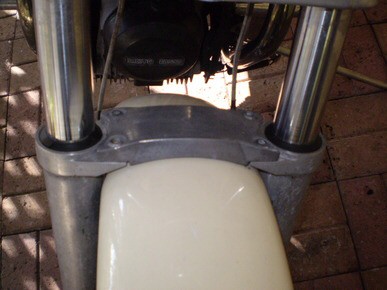
Photo courtesy of Rod Yeomans.
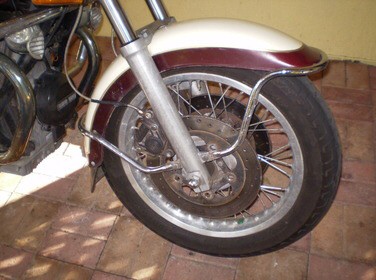
Photo courtesy of Rod Yeomans.
Another thing of interest is the domed 27 mm wheel nut. The nut on the rear axle is a 24 mm high tensile hex. Why the 2 sizes, I have no idea but it just doesn't seem practical from a weight or tool carrying point of view. Just remember that this bike is 66kg heavier than a 850 Le Mans III and over 50kg heavier than a 1000S. All these little bits of extra weight contribute to that massive difference and there are lots of others. To be fair though, compared to most of its competition, the Cali is a lightweight. There are many cruisers on the market, made in both imperial and metric systems that are considerably heavier and with much less ground clearance for cornering. The fuel tap defies my logic. Why would a remote fuel knob be fitted to a fuel tap that is not accessible under the tank when there is room to have the fuel tap in the normal position to the sides? The result is just this spongy indefinite feeling knob that gives no feedback as to whether the tap is in the correct position or not. It also doesn't get enough pressure on rotating the tap resulting in a slight fuel leak when the hoses are undone.There is no reserve facility, instead a low fuel warning light meaning faulty wiring or a blown bulb has the potential of getting the rider stranded. I've had to repair the wiring for the low fuel warning light. Wires in both plugs were broken and its no wonder considering the jiggle it is to lift the tank, feed the remote fuel cable through the frame and make sure the wiring doesn't get snagged on anything in the lift. All this extra complexity adds nothing to function but it does add weight and difficulty in removing and replacing the tank. The brake fluid level switch isn't fitted on the Cali unlike some other models. I don't see this as an issue as the warning light on the MK III has not gone off in 26 years. This bike has been fitted with stainless brake lines so there is a good feel to both the hand and foot lever. What really amused me though is the sign on the front and the rear master cylinder caps. The front cap states to only use DOT 3 or DOT 5 brake fluid but the rear cap states to only use DOT 4! Both are Brembo systems.
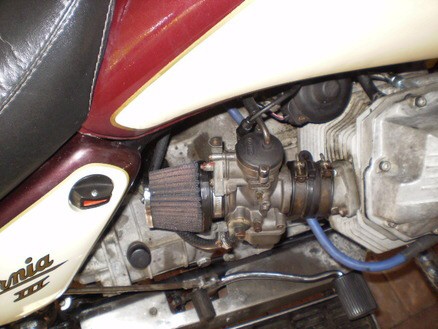
Photo courtesy of Rod Yeomans.
The PHF 30's look nice and accessible until you try and get to the slides or needles. The combination of angled cable adjuster, slide and pump lever mean that the carby has virtually to be removed before the slide and needle can be removed. It is just easier to remove the choke plunger and pull the carby off the inlet rubber. When investigating the jetting I found the bike virtually standard except the floats were too low and the needles, instead of being on the third notch, one was on the second and the other on the first! What I discovered was the throttle cables from the splitter to the carbs were too short and no matter what adjustments were made the slides were riding on the cables instead of the tapered throttle stops. With a bit of grinding on the adjusters and the use of taps and dies I shortened the adjusters and returned the floats and needles to standard. I haven't noticed any differences in fuel consumption yet but the bike is still running fine but really not noticeably better. Its been much easier to balance them and the bike is starting easily and idling well when warm. The cali has a static timing of 2 deg BTDC. That's not very much. I did find that the timing was a degree or so retarded. It took several attempts to get it just right so now its spot on the 2 deg. This is an early Cali III and I'm very happy about it. Instead of having the Motoplat ignition it must have come out with twin points. This particular bike is fitted with a Dyna III ignition system and so far it has been faultless. I partly attribute the bikes economical fuel usage to the Dyna. The bike doesn't suffer from pre ignition at all even though I'm running it only on 91 RON ULP rather than premium. The cheaper fuel and the miserly consumption really does make the bike economical transport. (Postscript. I received a message from member (Joe) that informed me that Ace, his mechanic, tunes these engines including his Cali II to 4 deg BTDC if a Dyna is fitted and he has noticed an increase in power. I only run the Cali on 91 RON fuel which actually pre ignites easier and burns faster than higher octane fuels so this may be the reason. I haven't tried this but I think it is worthy of note here.) Even after a full balance and timing check the motor feels no smoother. Its still got the pulsing vibration at all revs that the 850 doesn't have. It must just be in the crankshaft balance and the larger pistons. Compression on both cylinders is excellent and the motor pulls strongly throughout the rev range.The power is more than adequate for a cruiser, so much so that I don't even notice when a pillion is on the back. Its actually surprising considering the very small timing advance and the smaller valves the bike has. I'm getting much more accustomed to the foot boards, brake lever and heel/toe changer. I still prefer pegs and standard levers but I can happily cope. The issue I have with the brake is that your right foot has to be lifted and the lever located before braking can commence. With a peg the brake lever is just under you toe. A similar scenario happens with the toe changer. I have read positive reviews of after market brake levers available to eliminate the need to lift your foot but I've kept this one standard. The bike is made much more user friendly by both the stands. Even with its extra weight its actually easier to put on the centre stand than the Le Mans. The long actuating lever and the integral handle with the sissy bar make it so. The side stand extends a long way but it can give you a start. It touches ground but it can then slide before finishing in its final position that locks the stand from retracting until the load is released. This second motion allows the bike to lean over a fair way too, especially when loaded with gear. Once over it is a bit of a heave to get it upright again.
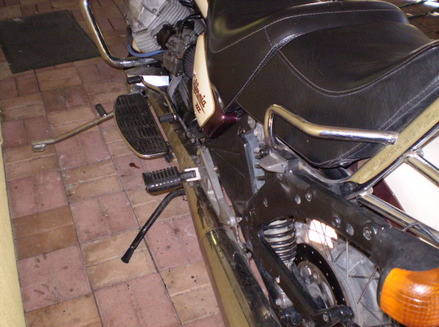
Photo courtesy of Rod Yeomans.
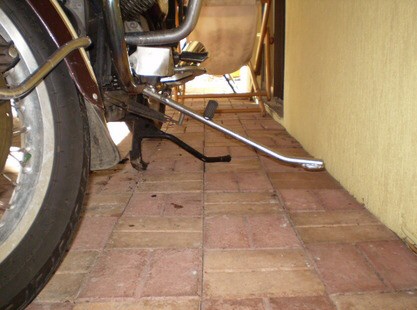
Photo courtesy of Rod Yeomans.
Overall I'm more than happy with my individual machine. The basics are all there, in good condition and importantly everything works. Its taken some sorting out and its not finished yet as there are 21 years of previous owners jobs to check out and I'm handling each as I find. The cosmetics will come last, well and truly last. The 25 litre tank and good economy gives it an enviable range so it has great potential as a tourer too. I also like the lighting options the bike has. There are just lots of places to stick driving lights or move indicators to. To keep or not to keep that is the question.... After 6 weeks of ownership: I just couldn't live with the standard bars any more. If I was going to keep the bike they had to be changed and I found a relatively cheap set of MCS Daytona bars. About 750 mm wide × 130 mm rise × 80 mm pull back. The crown was only 150 mm so the outsides of the covered bar bracket needed to be filed to suit. They dramatically change the character of the bike for me. Sitting position is just slightly forward and the throttle twist is the way I prefer it. The bars could have been just a bit wider to help fit all the gear on the outside straight section but they did at a squeeze. Cables were the next issue. The original clutch cable was just over 1.6m long and I now needed something around the 1.3-1.35m but no Guzzi cable seemed to fit. I found a generic clutch cable kit fitted perfectly for around half the price and I was so pleased I bought a second as a spare. The single throttle cable to the splitter needed to be much, much shorter too. I found the spare cable from my Sessantacinque GT fitted perfectly even though it didn't have a cable adjuster on it. It works perfectly and there are adjusters on the carbs but they are in as far as they can go. Hopefully a bit of inner cable stretch will help but it isn't really important as they are both nicely synchronised. I had removed the front end as one of the headlight brackets needed to be removed to be welded. I took this opportunity to fit fork gaiters to the bike. The fork chrome was in very good condition and I prefer gaiters to protect the surface from stone chips and thus save the fork seals. Mirrors were the next priority. The originals were designed for the original bars. They had no sideways reach so if I fitted them my body and arms would block any view. With very little bar space left I tried some bar end mirrors. They worked quite well and gave good rear vision but being so wide apart they needed a deliberate decision to move my head as they were a fair way off the centre line of my vision.
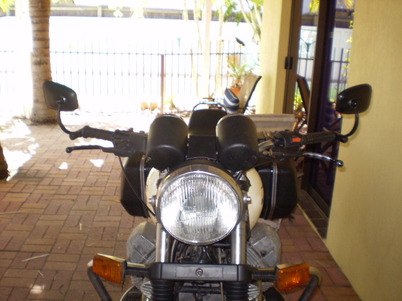
Photo courtesy of Rod Yeomans.
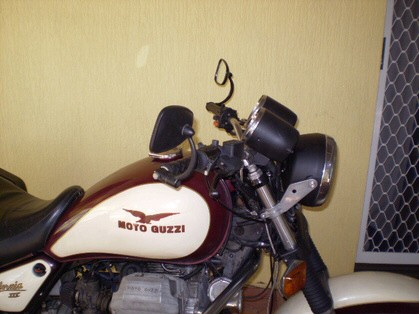
Photo courtesy of Rod Yeomans.
I still had a set of standard raised mirrors from my original MK III Le Mans. I was able to purchase a mirror bracket and some bar end weights to enable these to be fitted. The end weights effectively lengthened the bars 20 mm each side and the bracket had a 10 mm thread suitable for the LH mirror. Luckily, the front master cylinder body had the provision for a mirror already. I'm now much happier with the bike's ergonomics. The position is comfortable and the vision to the rear is excellent. I'm still in the process of putting the bike on a diet but overall I'm satisfied that the bike is capable of having me on it for lots of hours and over lots of distance. I would happily jump on it and ride to see my Aunt in Melbourne over 2,000 km away. I even enjoy the fact that it isn't as good a motor as the 850 MK III. Its rougher and less refined so the bike tends to growl at all revs. Sitting on the wide comfortable saddle, straddling the 25 litre bulbous tank the bike emits a presence and a note worthy of it. I let a café owner I know, who owns a Triumph Tiger, take it for a ride. He had never ridden a bike with linked brakes, let alone foot boards before but he came back from a ride through a nice twisty section shaking his head in disbelief. He couldn't get over how stable it was, how much clearance it had and how evenly the engine provided the power. In probably one of the most complimentary comments I have ever heard he said my son wants a bike and he is interested in a Triumph like mine but I wish he would buy something like that. The Triumph is so twitchy but that is just so stable and re-assuring.
Nothing else need be said, really.
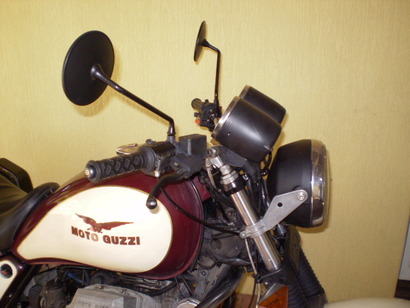
Photo courtesy of Rod Yeomans.
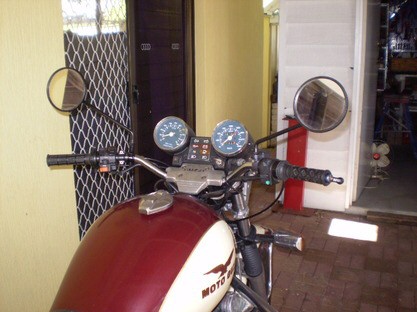
Photo courtesy of Rod Yeomans.
After 6 Months: The bike has been through a colour transformation and now is Silver. Exactly the same metallic silver that the LM III was available in. I like the simple uncomplicated look. I recently completed a 5000 km return journey on the bike and mechanically it is without fault but I can report a couple of design flaws. The electronic tachometer died. It just ceased to function and I found that it was a common issue. The electronic movement just doesn't like the constant vibration. Both 100 mm instruments are held by one small bracket attached to their base held to the central console by one solitary 5 mm bolt. This just isn't strong enough and I have had to repair it a couple of times. I am in the process of re-design to hopefully rectify the issue. One design feature that looks the goods for touring is actually a distinct disadvantage. The long steel guards, while looking like great weather, mud and stone protection actually make removing the wheels virtually impossible on the road despite the excellent centre stand. The rear wheel can't be removed unless it can be dropped away as it simply won't fit between the swing arm and the guard. The front wheel is not much better. If the bike is on flat ground it can't be tilted to the rear enough, before the rear wheel touches. This means that the front wheel can't be removed or replaced if the tyre is inflated. It comes close but just not close enough. I have noted that later models have different designed guards both front and rear. Still, for all its warts, I like it. On my recent trip I completed a 14 hour day to cover 1200 km. The excellent handling, fuel range and seat meant that at the end of the day I could still walk, talk and behave as an upright human rather than a tortured victim. It would have been a very different story on many other designs.
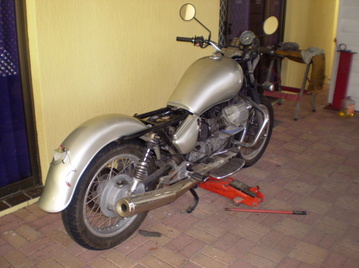
Photo courtesy of Rod Yeomans.
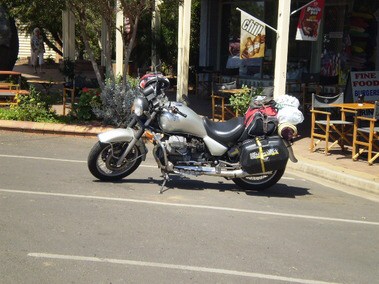
Photo courtesy of Rod Yeomans.
Technical Specifications California III Technical specifications
| Year | 1988-1993 |
|---|---|
| Bore (mm) | 88 |
| Stroke (mm) | 78 |
| Capacity (cc) | 948.9 |
| Compression (:1) | 9.2 |
| Valve type | ohv |
| bhp | 71 |
| @ RPM | 6800 |
| Torque (Kg-m) | 7.7 |
| @ RPM | 5200 |
| Starting system | Electric |
| Oil system | Wet sump |
| Valve timing | ohv |
| Inlet opens BTDC | 20 |
| Inlet closes ATDC | 50 |
| Transfer exhaust open BBDC | 44 |
| Exhaust closes ATDC | 10 |
| Tappets, inlet (mm) | 0.22 |
| Tappets, exhaust (mm) | 0.22 |
| Primary drive gearing | 1.235 |
| Final drive gearing | 4.714 or 5.333 |
| Box gearing: 5th | 0.750 |
| Box gearing: 4th | 0.869 |
| Box gearing: 3rd | 1.047 |
| Box gearing: 2nd | 1.388 |
| Box gearing: 1st | 2.000 |
| No. gears | 5 |
| Front tyre | 110/90 V18 |
| Rear tyre | 120/90 V18 |
| Front brake (mm) | d/disc 300 |
| Rear brake (mm) | disc 242 |
| Front suspension | telescopic |
| Rear suspension | swingarm |
| Ignition system | coil |
| Wheelbase (mm) | 1550 |
| Ground clear, (mm) | |
| Width (mm) | 970 |
| Length (mm) | 2330 |
| Dry weight (kg) | 272 |
Carburetor settings:
| Dell'Orto type | Size | Main | Pilot | Slide | Needle | Needle Position | Needle Jet |
|---|---|---|---|---|---|---|---|
| PHF 30DS/DD | 30 | 125 | 50 | 50/3 | K23 | 3 | 265AB |